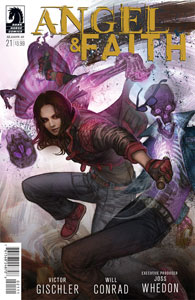“Angel & Faith” wraps Season 10 with the five-part “A Tale of Two Families” (Issues 21-25, December 2015-April 2016), which affirms the themes I’ve remarked on in previous posts. A makeshift family has formed around Angel in Magic Town; they are voluntarily drawn to him based on the good example he sets. This contrasts with Archaeus, who recruits vampire minions with the promise of power.
The difference between the two “families” is also the difference between winning and losing, because the pivotal factor is a giant statue containing the adolescent magic that came about from Whistler’s magic bomb at the end of Season 9, and which Nadira has been babysitting since then. The embodied magic sees that Angel’s example is morally superior, chooses his side and swings the tide of the battle. The statue is like if Frankenstein’s monster came about by magic instead of science, and if it was shown the good side of humanity instead of only the bad side.
There’s no arguing with the messages in “A Tale of Two Families,” and I adore the final rooftop picnic with all the heroes. Angel struggles to unwind (“Relax? I can relax. I’ll relax more than anyone here,” he unconvincingly tells Faith), and Fred teaches Koh – who is manning the grill — about potato salad.
All that having been said, this season finale doesn’t offer many surprises, and the banter that works well in the epilogue isn’t present before that as much as it could be. The closest to a surprise is that Angel turns into Angelus at the end of Issue 21 and takes up that guise for a bit after that.
We aren’t let in on the fact that Angel is acting until he whispers to Nadira that he’s faking it, so this is an exact repeat of the trickery (of the audience and the villain) from “Enemies” (“Buffy” 3.17). In both cases, Angel is so good at acting like Angelus that it’s disturbing, but in this case we’re missing the pleasure of watching David Boreanaz chew scenery. And it might’ve been neat to see Angel and Faith discussing this plan to trick Archaeus, considering that she is the villain in “Enemies.” I guess writer Victor Gischler didn’t want to spoil the surprise, although it’s not much of one anyway.
While the good guys’ attempts to get the magic on their side plays out nicely, I think it’s strange that the heroes try to convince Drusilla to recognize Archaeus’ false promise of family and walk away from him. I’ve noted that Gischler doesn’t write Drusilla’s dialog as crisply as some other writers do, but the fact that she would follow Archaeus strikes me as the logical play for her, and not a case where she’s being manipulated. She is totally the type to get swept up in the latest big action in town, and it would mean a lot to her that Archaeus is her ancestor in vampire lineage. I guess it’s standard practice for heroes to attempt to talk down villains from their evil scheme, but everyone should know Dru is beyond reason.

The Fred-Illyria coexistence plays out in understated fashion, with Illyria backing down after Koh explains that he’s not seeking revenge on her anymore – he has chosen to be the one to end the cycle of violence. It’s a Pollyanna notion, but it’s an appealing one, I admit.
Archaeus, although nicely designed by artist Will Conrad as a bony death’s-head spider creature, ultimately doesn’t stand out among Buffyverse villains – aside from the fact that he is the one who sired The Master. The conflict of “A Tale of Two Families” is like that in “Teenage Mutant Ninja Turtles” (1990): a coerced family of criminals versus a loving family of good people. Archaeus wants power and recruits vampire minions to try to achieve it, then fails in a predictable way.
In the end, the biggest strength of “Angel & Faith” Season 10 is the artwork by Conrad and colors by Michelle Madsen. Magic Town is an evocative place, with humans-turned-creatures milling about old brick architecture in London. Gischler does a great job bringing the heroes together in “United” (Issues 11-14) and introducing engaging threads for the ensuing issues. But ultimately, in this great setting, these great characters go through a rather standard adventure.
Click here for an index of all of John’s “Buffy” and “Angel” reviews.

